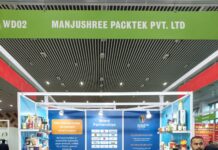
ITC, one of India’s leading conglomerates, set up a sprawling and modern facility in Haridwar in 2007 that houses three business units – foods, personal care, and packaging & printing. The packaging and printing unit is spread across around 28 acres of the 70-acre complex. The highly automated unit makes monocartons, flexible packaging (laminates, pouches) among others. At present, the unit employs about 650 people and supports significant livelihoods.
The plant started with a carton line and two flexible packaging lines in 2007. In 2012, the unit expanded and diversified into tobacco packaging while augmenting its offset and flexible printing lines with backward integration into a blown film line. In 2015, the company started making gravure cylinders at site for tobacco and flexible packaging. Subsequently, the company made further investments for enhancing capabilities for all three segments of the unit.

For monocartons, a Heidelberg XL105 and a Koenig & Bauer Rapida 106 multicolor offset presses are used with a comprehensive finishing converting section that includes lined cartons, window patching, sheetfed gravure, foil stamping, lamination, die-cutters and folding gluers. All the advanced post-printing equipment have been sourced from global suppliers such as Bobst, Heiber Schroder, Steinemann etc.
A Macchi blown film line, two Bobst Rotomec print lines, solvent-based and solvent-less lamination from Schiavi and Nordmeccanica, extrusion machines, downstream slitter-rewinders from Titan, micro-perforation lines, and pouching lines comprise the flexible packaging infrastructure.

Vipul Arora, general manager, business – growth and excellence, says that while the carton plant can print up to 65-70 lakh sheets monthly, the volumes are determined by job complexity and customer requirements.
While most of the supplies from the unit are for the Northern states, about 10% of the unit’s production is shipped to other regions of the country. ITC’s new plant in Nadiad, Gujarat, serves the Western India market with faster and better turnaround times for clients, Arora says. He says food and beverage are its largest customer segments followed by home and personal care and nutraceuticals.”

The company uses gravure printing for tobacco cartons and flexible packaging. Food and beverages are the largest customers for flexible packaging, including staples such as atta, followed by sugar, besan, etc. In addition, we produce packaging for snacks.” Several ITC flexipack clients are from the fertilizer and handwash segments.
For its gravure presses, ITC uses solvent-based inks from Siegwerk and DIC while for offset, it has a Siegwerk ink kitchen and sources some inks from Hubergroup and Toyo. The company has been working on water-based inks on gravure but he says that there is some ground to cover before bringing these into full-fledged production. For direct food contact items, the company uses food-safe and low migration inks.
According to Arora, there is a misconception that ITC’s packaging and printing plant is for only the company’s products “In cartons and flexibles, 75% sales are for non-ITC customers and only 25-30% of the products are sold to ITC. In terms of layout, automation, and especially sustainability, our packaging unit is world class and way ahead of others,” Arora said.
Sustainability initiatives
ITC has a three-megawatt rooftop solar rooftop plant. Some energy is sourced from windmills down south through wheeling. It is a zero-liquid discharge site as 100% of the water consumed is reused and recycled. The plant recharges more water than it withdraws from the ground through an extensive rainwater harvesting network. The unit is also home to many species of flora and fauna, he said.
“We offer multiple customized sustainable packaging solutions in both flexibles and cartons. ITC is at the forefront in replacing metpet/PE cartons with plastic-free options. In flexibles, we can add value for clients through a multi-pronged strategy of intensity reduction, mono-family structures etc. We have a variety of recyclable, compostable/biodegradable solutions as thus far defined by Indian EPR regulations. We have done well in the QSR industry where PE-coated boxes have been replaced by paperboard combined with a proprietary ITC compostable coating called Bioseal, which replaces PE,” he says.

On logistical challenges, he says “There are some constraints in terms of limited organized large-scale transporters, together with freight time and costs being higher compared to other countries. However, there is marked improvement with state border entries not being a problem any longer.”
As consumption grows, the packaging industry will grow, Arora says, adding that although there is a buzz around sustainable packaging, much depends on how and when brands take it forward.
The Indian packaging industry is getting more organized with increased consolidation in the recent past. He says equity investors are keen to pump money into the Indian packaging industry and the industry is definitely poised to witness robust growth in the coming years.
In 2022, ITC started a greenfield packaging and printing unit in Nadiad, midway between Ahmedabad and Vadodara. While there are no current plans for any other greenfield plants, Arora says, expansion in terms of new lines and consumer segments will continue to take place in the units in line with the needs of the customers and future potential.
IndiFoodBev — authentic, impactful and influential
An English-language food and beverage processing and packaging industry B2B platform in print and web, IndiFoodBev is in its third year of publication. It is said that the Indian food and beverage industries represent approximately US$ 900 billion in revenues which implies more than 20% of the country’s GDP. Eliminating the wastage on the farmside can help to deliver more protein to a higher number of the population apart from generating sizable exports. The savings in soil, seeds, water, fertilizer, energy and ultimately food and nutrition could be the most immense contribution that country is poised to make to the moderation of climate change.
To improve your marketing and grow sales to the food and beverage processing and packaging industry, talk to us. Our research and consulting company IppStar [www.ippstar.org] can assess your potential and addressable markets in light of the competition. We can discuss marketing, communication, and sales strategies for market entry and growth.
Suppliers and service providers with a strategy and budget for targeted marketing can discuss using our hybrid print, web, video, and social media channels to create brand recognition linked to market relevance. Our technical writers are ready to meet you and your customers for content.
The second largest producer of fruit and vegetables in the world is continuously expanding processing capacities and delivery systems with appropriate innovative technologies. We cover product and consumer trends, nutrition, processing, research, equipment and packaging from farm to thali. Get our 2025 media kit and recalibrate your role in this dynamic market. Enhance your visibility and relevance to existing markets and turn potential customers into conversations. Ask for a sample copy of our bi-monthly in print or our weekly IndiFoodBev eZine each Wednesday.
For editorial info@ippgroup.in — for advertisement ads1@ippgroup.in and for subscriptions subscription@ippgroup.in
Naresh Khanna – 10 February 2025
Subscribe Now










